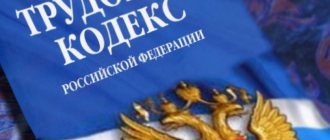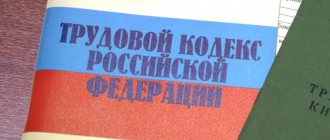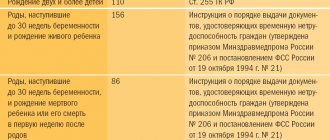Normative base
Decree of the Government of the Russian Federation of 05.08.2008 No. 583
Decree of the Ministry of Labor of 10.10.2003 No. 69
Order of the Ministry of Education and Science of the Russian Federation dated December 22, 2014 No. 1601 “On the duration of working hours (standard hours of teaching work per wage rate) of teaching staff and on the procedure for determining the teaching load of teaching staff, specified in the employment contract”
Unified recommendations for establishing remuneration systems for employees of state and municipal institutions for 2021 at the federal, regional and local levels
Letter of the Ministry of Education and Science dated December 29, 2017 No. VP-1992/02
New wage system
From 1992 to 2008 in the Russian Federation, public sector employees, including teachers, were paid based on a single tariff schedule - a rank system that made it possible to calculate a teacher’s salary taking into account his level of qualifications. From December 1, 2008, this method began to be abandoned, but the reform and implementation of the new wage system (NSWTS) is still ongoing.
For those who have already switched to the new method, the salaries of education workers include:
- salary;
- incentive payments;
- compensation allowances.
The employer accrues additional amounts based on the established wage regulations. But some managers, having access to finance, not only do not pay bonuses, but also lower salaries. In order to prevent a situation where the salary is below the minimum wage, officials propose to stipulate in the law the need to comply with the “70/30” proportion, where 70% comes from salary, and the rest from allowances.
The management of educational organizations is obliged to familiarize employees with the staffing table and tariff list (paragraph 4, clause 3.1 of the Ministry of Labor Resolution No. 69 of October 10, 2003 “On approval of the Instructions for filling out work books”).
How is the salary of a primary school teacher calculated and how is it calculated for subject teachers:
Read more: Effective contract in education: sample filling
Increase in salaries for teachers from January 1, 2021 in Russia
2020 turned out to be extremely rich in various economic events. This year the pandemic came, many employees of budgetary institutions had to go remote, and not everyone was able to return to their workplace.
From January 1, 2021, the minimum wage was increased.
Also, following the increase in wages, the Government decided to raise social payments to the population, first of all this concerns
- pensions
- maternity benefits,
- payments to mothers for children under 3 years of age
- Putin's payments for children from 3 to 7 years old.
Innovations await teachers too:
- length of service for early retirement will be taken into account in a new way,
- Opportunities for preferential housing have been added.
But the increases did not stop there and, at the proposal of the Head of State, it was decided to raise the minimum wage.
From January 1, 2021, the minimum wage will be 12 thousand 792 rubles
By the way, the Central Bank of Russia expects that public sector salaries will increase by 4% on average in 2021, and this will exceed projected inflation.
school canteen
It would seem that what is so special about the next increase in the minimum wage? Does this really affect anything? It turned out that it has a very serious effect.
A significant part of public sector employees, that is, employees of public sector institutions, work for salaries at the minimum wage level - this is the overwhelming majority of administrative and technical personnel, a significant part of the teaching staff, and support workers.
in the school library
After all, a school or college is not only the director and teachers, there are also cleaners, technicians, school bus drivers, and many other not very noticeable specialists on whose shoulders the functioning of organizations rests.
All of them are assigned wages within the minimum wage or even a share of the minimum wage (part of the rate, part-time). What is important is that all these employees will have their salaries increased from January 1 - after all, educational institutions belong to the public sector and here they very carefully monitor the implementation of any legal norms.
classroom cleaning
Listed below are the main professions in the education system that will see a salary increase.
How to calculate your salary using the new system
The Russian Tripartite Commission for the Regulation of Social and Labor Relations, together with the Ministry of Education and Science, in 2021 developed new unified recommendations for 2021 (approved by the decision of the Russian Tripartite Commission for the Regulation of Social and Labor Relations dated December 24, 2019, protocol No. 11). They require the following payment components to be included in the employment contract:
- fixed salary;
- wage rate;
- provided compensation payments and their amount;
- conditions for receiving incentive bonuses.
The rate is set per calendar month or per labor standard. This refers to the number of academic hours that must be worked in a certain period for a salary rate. Usually the norm is set at 18 hours per week.
Incentive payments, according to the letter of the Ministry of Education and Science dated December 29, 2017 No. VP-1992/02, include:
- for intensity (for example, work at 2 rates);
- for high results (student achievements, government awards);
- for continuous work experience;
- for the quality of work (for example, the use of innovative pedagogical technologies);
- bonuses based on the results of the reporting period.
Compensation payments are provided for work in extreme climatic conditions, overtime, combining positions, and working on weekends or holidays.
As an example, let’s consider what salary a teacher of Russian language and literature of the highest category with 16 years of experience will get with the following initial data:
- official salary - 5,000 rubles;
- works 20 hours a week;
- bonus for length of service - 500 rubles;
- increasing coefficient for the highest qualification category - 0.2;
- surcharge for checking written work - 0.1.
We receive for the load: 5,000 rubles. / 18 × 20 = 5,555.56 rubles.
For the category, the additional payment will be: 5,555.56 x 0.2 = 1,111.11 rubles.
For checking the work: 5,555.56 x 0.1 = 555.56 rubles.
We add another 500 rubles for continuous service.
As a result we get:
5,555.56 + 1,111.11 + 555.56 + 500 = 7,722.23 (rub.)
Category allowance for teachers
To undergo certification in order to confirm the employee’s suitability for the position held, the employer prepares a submission. If a teacher works in different teaching positions for one employer and does not have a qualification category for any of them, then the employer’s representation can be submitted immediately for all positions in which he is employed.
The purpose of certification is to stimulate the growth of qualifications, professionalism, the effectiveness of teaching and management work, the development of creative initiative, and ensuring legal and social protection of industry workers.
Calculation based on base salary
Not all regions have yet switched to NSOT; there are some where the calculation remains based on salary. If the algorithm for calculating teachers' salaries is based on salary and depends on the actual volume of work performed, the annual workload is necessarily fixed in the employment contract. In organizations of secondary vocational and higher education, this indicator sometimes changes by semester. Therefore, it is recommended to register the load separately for each half-year.
According to the official salary, the salary is usually set for those teaching employees for whom the duration of working hours (WH) is clearly established. It does not depend on the load. From the order of the Ministry of Education and Science No. 1601, the period of time in the field of education does not exceed 36 hours.
The official salary is established for educational psychologists, social educators, and organizers. That is, for those who are at work all day, regardless of the number of lessons.
Compensation and incentive payments are sometimes added to the official salary.
Calculation at a fixed rate
Every year, educational institutions approve tariffs. For a salary rate, a teacher works a certain number of hours. Based on this, the base salary is determined. But increasing coefficients are applied to it, allowing you to increase income:
- for the qualification category (maximum 1.15);
- for carrying out labor activities in rural areas;
- for the education of orphans;
- for working with children with disabilities;
- for the presence of students with deviant behavior in the class.
The coefficients are summed up, and sometimes all of them (except for K - for the category) are replaced with compensation payments.
Let's see how to calculate the salary of a primary school teacher with a workload of 23 hours a week and the highest qualification category at a rate of 6,000 rubles for 18 hours.
Income = 6,000 × 23 / 18 × 1.15 = 8,817 rubles.
Some schools set an increasing coefficient for the age characteristics of students. And it is primary school teachers who receive them.
Salaries of university teachers, assistants and professorial staff
It is worth noting that many teachers in the regions literally work for the idea, combining teaching with other work or business. Many universities register employees for only 0.25 or 0.5 rates. Therefore, many employees receive very small amounts in hand.
| Assistant without a degree | 12000 rub. |
| Teacher, associate professor | 17000 rub. |
| Professors | 30,000 rub. |
| Candidate of Sciences at a regional university | 9000 rub. |
| Teacher, associate professor at a regional university | 10000 rub |
Decent wages, by and large, are only available in universities in Moscow and certain universities in St. Petersburg.
How the disciplines taught affect salaries
Another important question is what the salary of a subject teacher consists of. The letter of the Ministry of Education and Science dated November 26, 2006 No. IK-244/03 stated that increasing coefficients are also used for the complexity and priority of the subject. Teachers have the right to count on this privilege:
- Russian language;
- mathematics;
- foreign languages;
- subjects in which most students take the Unified State Exam.
An increase in income is also possible for those who teach subjects that involve hazardous working conditions (physics, chemistry).
Foreign language teachers and salaries
Today it is fashionable and even necessary to learn foreign languages, because this is a direct path to success and decent income, as well as the opportunity to travel freely. It’s easy to imagine how an English teacher’s salary is calculated and what it consists of.
Provided that, for objective reasons, the school management is not able to give additional workload to the teacher, he is guaranteed a salary at the same level as if he had assumed additional responsibilities. In this case, there is a good opportunity to help the student learn the material in a foreign language and prepare him for participation in English Olympiads.
How are English teachers' salaries calculated? Just like other teachers. Another advantage of teaching English is that the teacher can always earn extra money by tutoring.
Apprentice-hour wage
In essence, this is an hourly wage, where the employee’s income depends on the amount of work he performs. Most often it is used in relation to part-time workers.
The management sets a certain cost for one academic hour (one lesson at school, half a lesson at a college or university). But sometimes the formula also includes the number of students in each class. In secondary vocational and higher education, the number of students is used only when calculating fees for exams and tests.
According to the letter of the Ministry of Education and Science No. IK-244/03, the salary of a teaching worker carrying out the educational process is calculated according to the formula:
If a teacher teaches several subjects in different classes, then his salary is calculated for each subject and class separately. Let’s calculate approximately how much a mathematics teacher earns if he:
- teaches 525 people throughout the school;
- works 36 hours per month;
- for the complexity of the subject will receive a coefficient of 0.1, and for the category - 0.2;
- cost per student/hour - 20 rubles.
Substitute into the formula and get:
20 x 525 x 36 x 0.1 x 0.2 = 7,560 (rub.)
In addition to this amount, he will be paid extra for checking notebooks, class management, maintaining the office, and other duties.
What does a teacher’s salary consist of and how is it calculated?
The basic part is formed in accordance with the number of working hours (classroom load) and the number of schoolchildren who attend one lesson. This also includes extracurricular workload - the teacher conducting additional projects, checking homework in students’ notebooks, class management, responsibility for the proper condition of the classroom, extracurricular activities with gifted children identified by special testing, working with students who require help in correction groups.
We recommend reading: What documents are needed to buy and sell a house?
The worst thing is that in such harsh conditions, deputies do not offer any alternative to where an impoverished teacher can find a job or where rural children can study. As a result, it is primarily the latter who suffer, having to travel 5-10 km to the nearest educational institution.
How much do teachers earn on average?
Regardless of the payroll method, payments to public sector employees are increased annually to the level of inflation or higher. The budget for the current year plans to increase by 5.4%, in 2021 they promise to raise salaries by 6.6%, and a year later - by 6.1%. There are also the so-called “May Decrees”, which stipulate that the authorities are obliged to raise the salaries of school teachers to 100% of the average labor income in the region, and for university teachers - to 200%. Therefore, for some, nominal wages will increase significantly.
For now, the situation with teachers’ salaries is as follows (according to Rosstat data for the first quarter of 2021):
| Pedagogical workers of preschool educational organizations | Teaching staff of educational organizations of general education | Teachers of educational institutions of higher professional education | ||
| Russian Federation | 34 257 | 41 990 | 87 737 | |
Central Federal District | ||||
| Belgorod region | 33 312 | 37 666 | 64 878 | |
| Bryansk region | 25 749 | 27 274 | 52 693 | |
| Vladimir | 28 815 | 31 998 | 62 988 | |
| Voronezh | 26 769 | 29 765 | 61 234 | |
| Ivanovo region | 22 882 | 24 794 | 48 526 | |
| Kaluga region | 31 543 | 35 324 | 74 549 | |
| Kostroma | 26 721 | 28 351 | 56 005 | |
| Kursk region | 26 449 | 29 734 | 60 011 | |
| Lipetsk | 28 465 | 31 261 | 64 528 | |
| Moscow region | 51 914 | 55 001 | 104 026 | |
| Oryol Region | 24 723 | 26 908 | 54 879 | |
| Ryazan | 27 050 | 31 094 | 61 496 | |
| Smolensk | 25 126 | 28 708 | 56 693 | |
| Tambov Region | 24 114 | 26 230 | 54 644 | |
| Tver | 26 568 | 29 036 | 59 611 | |
| Tula | 31 429 | 34 182 | 78 128 | |
| Yaroslavl | 29 412 | 31 610 | 64 479 | |
| Moscow | — | 96 957 | 144 848 | |
Northwestern Federal District | ||||
| Karelia | 37 612 | 39 642 | 81 011 | |
| Komi | 41 683 | 49 150 | 81 855 | |
| Arkhangelsk region, including: | ||||
| Nenets Aut. district | 60 246 | 73 932 | — | |
| Arkhangelsk region without a car. districts | 36 637 | 44 014 | 88 558 | |
| Vologda Region | 35 475 | 37 255 | 70 584 | |
| Kaliningrad | 31 848 | 33 760 | 64 437 | |
| Leningrad region | 45 672 | 47 641 | 82 477 | |
| Murmansk | 48 278 | 56 459 | 105 750 | |
| Novgorod | 27 352 | 29 212 | ||
| Pskov region | 25 329 | 28 090 | 54 039 | |
| Saint Petersburg | 56 831 | 59 907 | 116 899 | |
Southern Federal District | ||||
| Republic of Adygea | 25 045 | 27 965 | 57 840 | |
| Kalmykia | 23 996 | 26 765 | ||
| Crimea | 25 388 | 30 449 | 56 327 | |
| Krasnodar region | 30 400 | 33 448 | 67 660 | |
| Astrakhan | 26 342 | 30 232 | 59 743 | |
| Volgograd | 26 923 | 29 060 | 58 367 | |
| Rostov region | 26 165 | 30 561 | 62 833 | |
| Sevastopol | 30 720 | 38 980 | 65 026 | |
North Caucasus Federal District | ||||
| Dagestan | 20 256 | 24 856 | 45 666 | |
| Ingushetia | 22 381 | 22 890 | — | |
| Kabardino-Balkaria | 20 398 | 23 194 | 49 833 | |
| Karachay-Cherkess Republic | 21 970 | 23 026 | 47 208 | |
| Republic of North Ossetia-Alania | 20 611 | 24 791 | 50 257 | |
| Chechen Republic | 22 139 | 25 774 | 51 660 | |
| Stavropol region | 23 838 | 26 646 | 53 449 | |
Volga Federal District | ||||
| Bashkortostan | 30 973 | 33 791 | 67 753 | |
| Mari El Republic | 24 822 | 27 920 | ||
| Mordovia | 22 153 | 24 693 | 54 113 | |
| Tatarstan | 29 733 | 33 978 | 76 956 | |
| Udmurt republic | 29 159 | 31 658 | 62 407 | |
| Chuvashia | 25 449 | 27 524 | 62 392 | |
| Perm region | 28 848 | 32 876 | 71 160 | |
| Kirov region | 25 614 | 27 783 | 55 147 | |
| Nizhny Novgorod Region | 29 699 | 32 400 | 70 463 | |
| Orenburg | 27 733 | 32 071 | 60 824 | |
| Penza region | 27 035 | 28 789 | 56 008 | |
| Samara | 29 234 | 31 877 | 68 247 | |
| Saratov | 25 922 | 28 648 | 53 659 | |
| Ulyanovsk | 25 007 | 27 550 | 56 658 | |
Ural federal district | ||||
| Kurgan region | 25 639 | 28 125 | 57 802 | |
| Sverdlovsk region | 36 251 | 40 675 | 77 141 | |
| Tyumen region, including: | ||||
| Khanty-Mansiysk Autonomous Region Okrug-Ugra | 59 033 | 67 338 | 141 007 | |
| Yamalo-Nenets Aut. district | 75 343 | 92 812 | — | |
| Tyumen region without cars. districts | 43 644 | 48 176 | 93 866 | |
| Chelyabinsk | 28 341 | 33 701 | 68 039 | |
Siberian Federal District | ||||
| Altai Republic | 26 906 | 28 890 | — | |
| Tyva | 28 194 | 32 307 | — | |
| Khakassia | 31 008 | 36 604 | 71 754 | |
| Altai region | 24 762 | 28 006 | 56 806 | |
| Krasnoyarsk region | 38 689 | 42 606 | 90 970 | |
| Irkutsk region | 36 584 | 41 216 | 83 577 | |
| Kemerovo region | 35 599 | 37 412 | 79 177 | |
| Novosibirsk | 32 144 | 35 202 | 72 070 | |
| Omsk region | 26 774 | 31 304 | 63 380 | |
| Tomsk region | 33 093 | 37 744 | 84 162 | |









